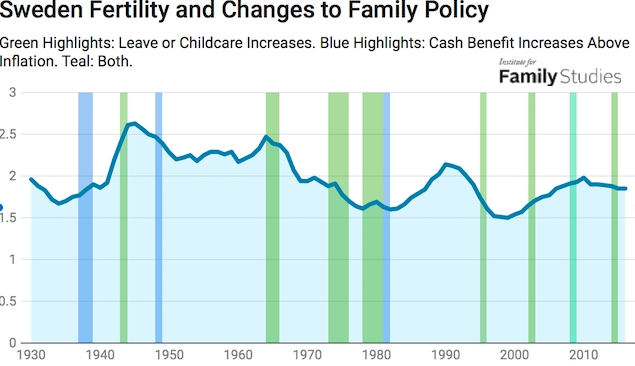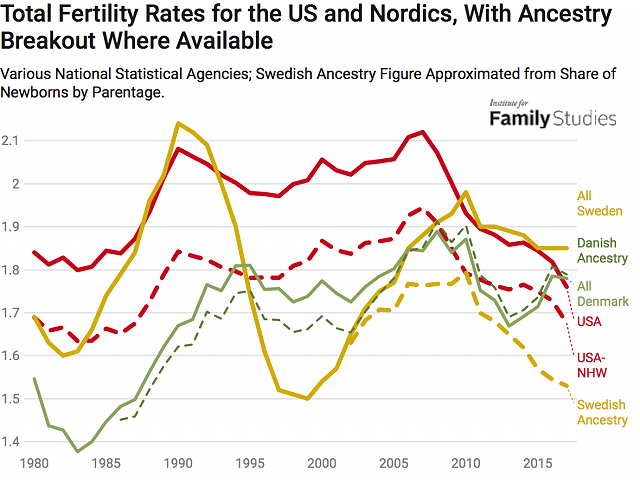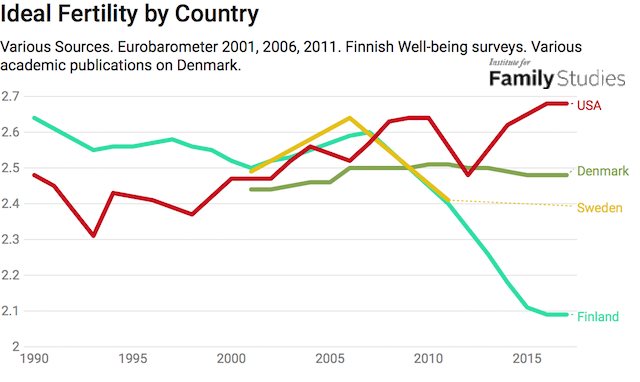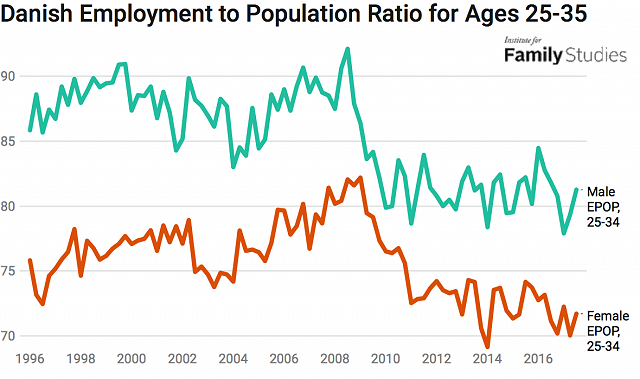Highlights
“American Women Are Having Fewer Children Than They’d Like,” I recently noted in an article for The New York Times. The article generated pushback, especially from progressives who charged me with ignoring the role that public policy may be playing in keeping American women from realizing their ideal number of children. Take this tweet about my article from Jill Filipovic:
Also telling to see an article hand-wringing about fertility decline, written by a man, that takes the time to blame birth control, lack of sex, and smartphones, but doesn’t mention paid parental leave, affordable childcare, or pregnancy discrimination.
Filipovic raises the possibility that better public policy could help eliminate the gap between women’s achieved and desired fertility. The truth is, that’s a reasonable thing to think: if fertility is low, wouldn’t government policies fix it? Indeed, on the right, this usually looks like expanding tax preferences aimed at childbearing and family. On the left, this usually means either more open immigration or else family-friendly workplace rules in line with the ideas mentioned by Filipovic. But while it seems intuitive, is it actually true that giving extensive paid family leave would boost fertility? Will women get closer to having as many kids as they say they want?
These questions are especially interesting because a number of scholars and politicians have proposed that “feminism is the new natalism.” By this, they mean that nations that pass policies designed to make it easier for women to juggle work and family, afford children, and share caregiving with fathers are likely to enjoy higher fertility levels.
So, is it true that countries with more progressive public policies (and gender norms) are avoiding the recent drop in fertility the United States has experienced?
The most straightforward way to test this is to look at places where such policies do exist. The most extensive family support programs in the world exist in the Nordic countries (Sweden, Norway, Finland, Denmark, and Iceland). All five countries provide direct payments to families with children, generous paid parental leave, and heavily subsidized public childcare. But does it have any impact on fertility?
The answer seems to be no. Or at least, not very much.

As the above figure shows, the Nordic countries and the United States have seen similar fertility trends in the last 35 years: troughs in the early or mid 1980s, a peak around the early 1990s, decline into the new millennium, then another peak just around the onset of the Great Recession, and, for the most part, decline ever since. Kid-friendly Finland, Norway, and Iceland have all seen declines as steep or steeper than in the United States. Sweden’s decline is slightly less pronounced, and Denmark has managed an increase in recent years; more on that below.
The key thing to note here is that U.S. age-adjusted fertility has usually been higher than most of the Nordic countries, despite less public support for childbearing. And it’s not because we have so much higher desired fertility either. In a 2011 Eurobarometer survey, near-completion-age women in Denmark and Finland both had higher ideal fertility than American women, Sweden was just a bit lower, and Norway and Iceland were left out of the EU-focused survey. In other words, despite generous childbearing support, Nordic women wanted more kids, but ultimately had fewer kids, than American women.
We can look at the specific policy history in at least one country as well to see what’s going on. For example, the chart below shows Swedish fertility, with highlighted areas showing instances of increases in the generosity of family benefits (there have been no unambiguous decreases of which I am aware).

There is no association between increases in family benefits and fertility. Assessing these as time-series interventions yields no significant results: Nordic-style policies just don’t budge fertility all that much. Similar results show up for other Nordic countries. While some policy interventions do have limited, especially short-term, effects, the average Nordic-style policy intervention doesn’t do very much for age-adjusted fertility. The academic literature on leave is mixed, but tends to show that there are substantial effects on short-term fertility as women pull births forward. But as I’ve discussed for financial incentives for childbearing, long-term effects are very modest, and many papers suggest there are no long-term effects at all.
The most compelling and widely cited paper on the topic suggests that adding an entire year of paid leave boosted the odds a woman had an extra birth within 3 years from about 32% to about 40%. Decomposing into annual odds, that comes to about 9.7% odds in a year before leave extension to about 11.7% after. Put in U.S. terms, that’s like saying a year of paid leave might boost the total fertility rate from 1.77 births per woman to about 1.81. That’s something. But it’s not a lot. A year of paid leave would also have significant impacts on employment, wages, or government costs, depending on how it is financed, so, as for financial incentives, we’re talking about a lot of cash for a little bit of fertility gain.
But it may be worthwhile to look at an example country in greater detail. While the U.S. has generally had higher fertility than Sweden, in recent years, that’s swapped, and Sweden is beating us!
Why? Is it that Nordic policies are finally turning the tide on fertility through generous social policies?
Nope! It’s immigration. This next figure shows fertility in the U.S. and Sweden, and also for Non-Hispanic Whites in the U.S., and Swedes born to two ethnic Swedish parents. The Swedish data is approximated based on the share of newborns who have two Swedish parents; actual TFR-by-ancestry data is not available from Sweden’s public statistical website, but while the exact level may be off, the general trend should be about right.
And that trend is down, indeed, down at about the same pace as the United States.

So why is Sweden’s fertility rising? It's rising because of non-Swedes, particularly immigrants from non-Western countries, and, in recent years, asylum-seekers from conflicted countries in Africa and the Middle East. Sweden has experienced incredibly high immigration in recent years; much higher inflow rates than the United States, and of largely lower-skilled individuals from high-fertility countries. That’s a recipe for higher fertility! The chart below shows that parts of Sweden with faster growth in the foreign-born population are also the parts with the best performance for age-adjusted fertility.

Now, if unlimited inflows of low-skilled immigrants from high-fertility countries qualifies as a “Nordic” policy then, sure, Nordic policies can boost fertility. But nowadays, the countries sending many immigrants to the United States, like China, India, and Latin America, have pretty low fertility too. We would have to ramp up inflows of immigrants from the interior of Africa or parts of the Middle East to get the bonus Sweden is experiencing.
Ancestry data is also available for Denmark, and in this case direct ancestry data, so it’s not approximated. And there we see that, in fact, Danish-ancestry women have higher fertility than Denmark on the whole! However, non-Western immigrants in Denmark have even higher fertility than Danish women and are a growing group.
But Denmark’s case is curious. Denmark is experiencing a positive fertility swing while other countries are declining, and it isn’t driven by immigration. What’s going on?
According to the 2011 Eurobarometer survey, Danish women have comparatively high ideal fertility, one of the higher ideal fertility rates in the European Union. In fact, desired fertility throughout the Nordic countries seems to be a bit above the Europe-wide average, which may surprise American readers who associate secularism with lower value placed on children. In fact, the lowest desired fertility rates in Europe, outside of formerly communist countries, are the southern European, Catholic strongholds of Italy, Portugal, Malta, and Spain.
Using a variety of government surveys and surveys conducted for academic publication, I’ve assembled a time series of ideal fertility for Denmark (Eurobarometer data, and also various recent academic studies), Sweden (Eurobarometer), Finland, and the United States (General Social Survey). And what it shows is striking.

Desired fertility has plummeted in Finland, and the limited data for Sweden suggests a similar trend may be ongoing. By contrast, desired fertility has remained essentially stable in Denmark, and has actually risen in the United States. This helps explain what’s happening. In Finland and perhaps also Sweden, fertility is falling because, since the recession, something is changing with cultural values for Finns and Swedes: women simply want fewer kids. This isn’t a long-running Nordic trait, but something fairly new. In Denmark, fertility fell during the recession, but fertility desires were more stable, so they bounced back post-recession.
U.S. fertility, meanwhile, has not bounced back, despite slightly rising ideal fertility. It is possible that Nordic-style family support policies can help explain how Denmark’s people were able to afford a fertility rebound so quickly.
On the other hand, maybe it’s dumb luck. Denmark is a very tiny country, and idiosyncratic factors hard to capture in the data could have large effects. Even amid general U.S. fertility decline, states as varied as Iowa, Nebraska, Kentucky, Louisiana, and West Virginia have managed to achieve multi-year periods of increasing total fertility rates. Random noise in the data can create the appearance of important differences.
And there are good reasons to think Denmark’s boom may be due to fleeting, idiosyncratic effects. First of all, Denmark did not significantly change the generosity of its family and child subsidies in recent years: inflation-adjusted outlays per child on child allowances of various kinds are basically unchanged for a decade or more. Nor did Denmark experience some religious revival: the share of births baptized in the Church of Denmark continues to decline, according to official statistics, even as the share of marriages officiated by a minister of the Church of Denmark also declines. Leave-taking can’t explain the change either, as parents actually take less leave per child as of 2015 than they did in 2009 or earlier. As for public child care, that also doesn’t seem to be the source: Denmark is experiencing above-general-inflation-rate increases in daycare rates, much like the U.S.
Meanwhile, there is a modest correlation between a recent drop in school enrollment and an increase in fertility. It is possible that something has recently changed regarding how much Danish women value getting a master’s degree, inducing more to prioritize a child first. The scatterplot below shows that age-cohort change in school enrollment is a reasonable predictor of change in age-specific birth rates.

But it’s not clear what’s causal here: did higher births induce less schooling? Or was schooling eschewed to enable more births?
One major factor we can probably rule out for Denmark is the economy. Employment-to-population has not recovered at all since the recession for prime-fertility-age Danes.

Whatever the cause, this boom is likely fleeting. The first three-quarters of monthly birth data for Denmark suggest that 2017 total fertility is likely to come in slightly below 2016, which may be the beginning of a new decline as Denmark converges to its neighbors’ fertility trends.
In sum, we don’t know exactly why fertility is falling across so much of the developed world. The persistent decline in fertility currently being experienced is nearly unmatched in its global breadth and its severity since the end of the baby boom in the 1960s and 1970s. But there’s one thing we do know: government policy tools, Nordic-style or otherwise, appear to have very limited impacts on long-term fertility. They may be good for other reasons, of course (I for one think more family leave for parents would be a great thing!), but their impact on women’s ability to achieve their desires is ambiguous at best.
Lyman Stone is a Research Fellow at the Institute for Family Studies, and an International Economist at the U.S. Department of Agriculture, where he forecasts cotton market conditions. He blogs about migration, population dynamics, and regional economics at In a State of Migration.














